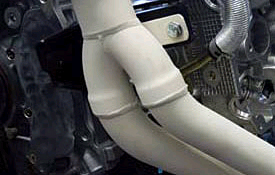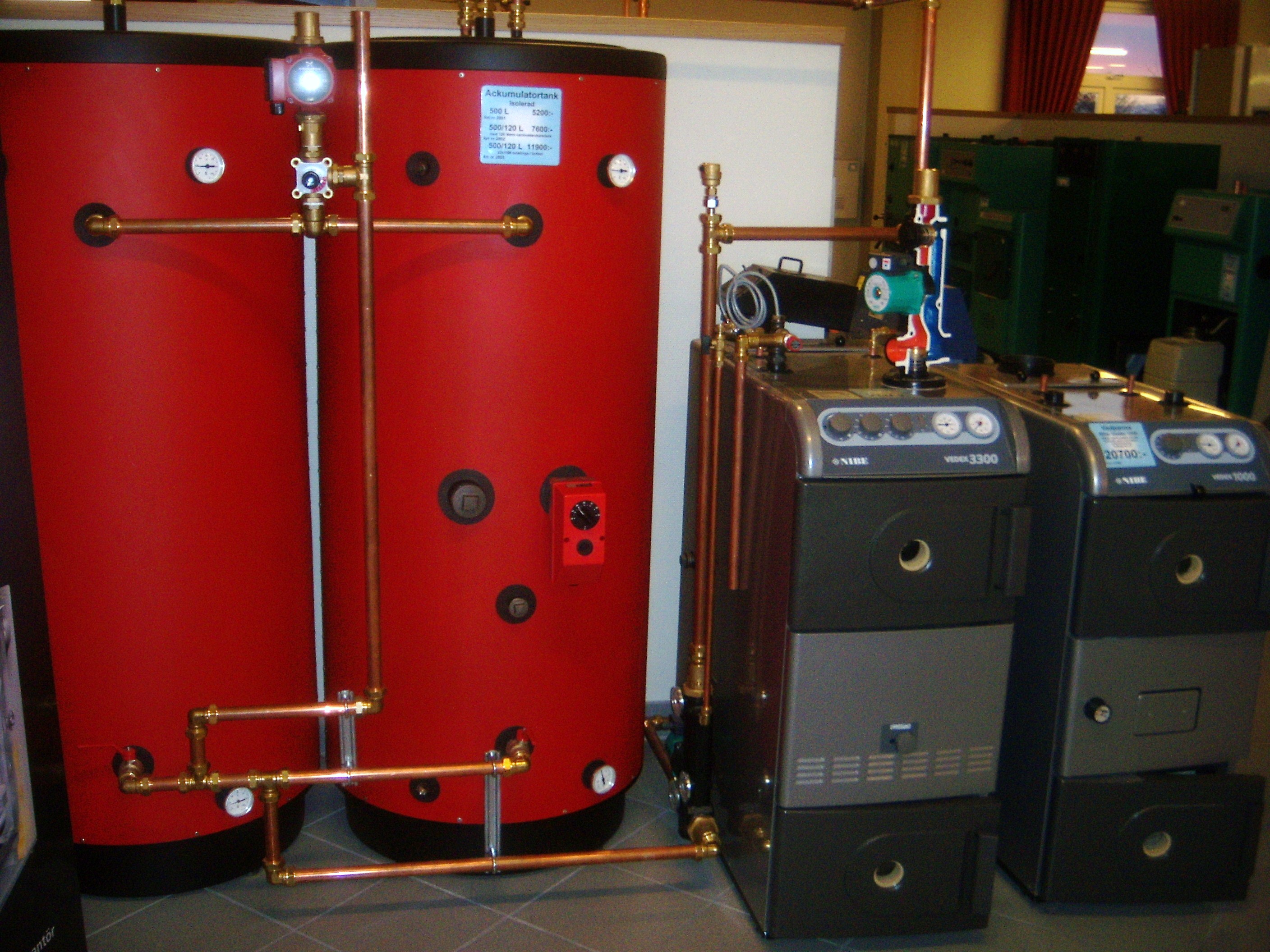|
Standing Loss
Standing loss, or standing losses, is a non-technical term to define energy losses in a system, usually associated with heat and hot water storage systems. It is the amount of energy lost through heat transfer to the surrounding environment; as such it is directly related to how well insulated a system is. A hot water storage tank, for example, will have a standing loss of heat; a proportion of the heat generated for consumption is lost through the cylinder walls by heat transfer, and useful heat provided to the end use (e.g., a hot water tap) is reduced. Standing losses are also associated with any pipework distribution system that is employed in the system as well. Standing losses are usually expressed as a unit of thermal energy such as in watt The watt (symbol: W) is the unit of Power (physics), power or radiant flux in the International System of Units (SI), equal to 1 joule per second or 1 kg⋅m2⋅s−3. It is used to quantification (science), quantify the ra ... [...More Info...] [...Related Items...] OR: [Wikipedia] [Google] [Baidu] |
Thermal Insulation
Thermal insulation is the reduction of heat transfer (i.e., the transfer of thermal energy between objects of differing temperature) between objects in thermal contact or in range of radiative influence. Thermal insulation can be achieved with specially engineered methods or processes, as well as with suitable object shapes and materials. Heat flow is an inevitable consequence of contact between objects of different temperature. Thermal insulation provides a region of insulation in which thermal conduction is reduced, creating a thermal break or thermal barrier, or thermal radiation is reflected rather than absorbed by the lower-temperature body. The insulating capability of a material is measured as the inverse of thermal conductivity, thermal conductivity (k). Low thermal conductivity is equivalent to high insulating capability (R-value (insulation), resistance value). In thermal engineering, other important properties of insulating materials are product density, density (ρ) ... [...More Info...] [...Related Items...] OR: [Wikipedia] [Google] [Baidu] |
Hot Water Storage Tank
A hot water storage tank (also called a hot water tank, thermal storage tank, hot water thermal storage unit, heat storage tank, hot water cylinder, and geyser) is a water tank used for storing hot water for space heating or domestic use. Water is a convenient heat storage medium because it has a high specific heat capacity. This means, compared to other substances, it can store more heat per unit of weight. Water is non-toxic and low cost. An efficiently insulated tank can retain stored heat for days, reducing fuel costs. Hot water tanks may have a built-in gas or oil burner system, electric immersion heaters. Some types use an external heat exchanger such as a central heating system, or heated water from another energy source. The most typical, in the domestic context, is a fossil-fuel burner, electric immersion elements, or a district heating scheme. Water heaters for washing, bathing, or laundry have thermostat controls to regulate the temperature, in the range of , and a ... [...More Info...] [...Related Items...] OR: [Wikipedia] [Google] [Baidu] |
Watt
The watt (symbol: W) is the unit of Power (physics), power or radiant flux in the International System of Units (SI), equal to 1 joule per second or 1 kg⋅m2⋅s−3. It is used to quantification (science), quantify the rate of Work (physics), energy transfer. The watt is named in honor of James Watt (1736–1819), an 18th-century Scottish people, Scottish inventor, mechanical engineer, and chemist who improved the Newcomen engine with his own Watt steam engine, steam engine in 1776, which became fundamental for the Industrial Revolution. Overview When an object's velocity is held constant at one meter per second against a constant opposing force of one Newton (unit), newton, the rate at which Work (physics), work is done is one watt. \mathrm. In terms of electromagnetism, one watt is the rate at which electrical work is performed when a current of one ampere (A) flows across an electrical potential difference of one volt (V), meaning the watt is equivalent to the vo ... [...More Info...] [...Related Items...] OR: [Wikipedia] [Google] [Baidu] |
EU Energy Efficiency Directive 2012
The Energy Efficiency Directive 2012/27/EU (abbreviated EED) is a European Union directive which mandates efficient energy use, energy efficiency improvements within the European Union. It was approved on 25 October 2012 and entered into force on 4 December 2012. The directive introduces legally binding measures to encourage efforts to use energy more efficiently in all stages and sectors of the supply chain. It establishes a common framework for the promotion of energy efficiency within the EU in order to meet its energy efficiency headline target of 20% by 2020. It also paves the way for further improvements thereafter. The directive provides for the establishment of indicative national energy efficiency targets for 2020. member states of the European Union, Member states were to have submitted their National Energy Efficiency Action Plans (NEEAP) by 30 April 2014, outlining the measures they have implemented to improve energy efficiency and their expected and/or achie ... [...More Info...] [...Related Items...] OR: [Wikipedia] [Google] [Baidu] |
Energy Storage
Energy storage is the capture of energy produced at one time for use at a later time to reduce imbalances between energy demand and energy production. A device that stores energy is generally called an Accumulator (energy), accumulator or Battery (electricity), battery. Energy comes in multiple forms including radiation, chemical energy, chemical, gravitational potential energy, gravitational potential, Electric potential energy, electrical potential, electricity, elevated temperature, latent heat and kinetic energy, kinetic. Energy storage involves converting energy from forms that are difficult to store to more conveniently or economically storable forms. Some technologies provide short-term energy storage, while others can endure for much longer. Bulk energy storage is currently dominated by hydroelectric dams, both conventional as well as pumped. Grid energy storage is a collection of methods used for energy storage on a large scale within an electrical power grid. Common e ... [...More Info...] [...Related Items...] OR: [Wikipedia] [Google] [Baidu] |
Residential Heating Appliances
A residential area is a land used in which housing predominates, as opposed to industrial and commercial areas. Housing may vary significantly between, and through, residential areas. These include single-family housing, multi-family residential, or mobile homes. Zoning for residential use may permit some services or work opportunities or may totally exclude business and industry. It may permit high density land use or only permit low density uses. Residential zoning usually includes a smaller FAR (floor area ratio) than business, commercial or industrial/manufacturing zoning. The area may be large or small. Overview In certain residential areas, especially rural, large tracts of land may have no services whatever, such that residents seeking services must use a motor vehicle or other transportation, so the need for transportation has resulted in land development following existing or planned transport infrastructure such as rail and road. Development patterns may be regul ... [...More Info...] [...Related Items...] OR: [Wikipedia] [Google] [Baidu] |



